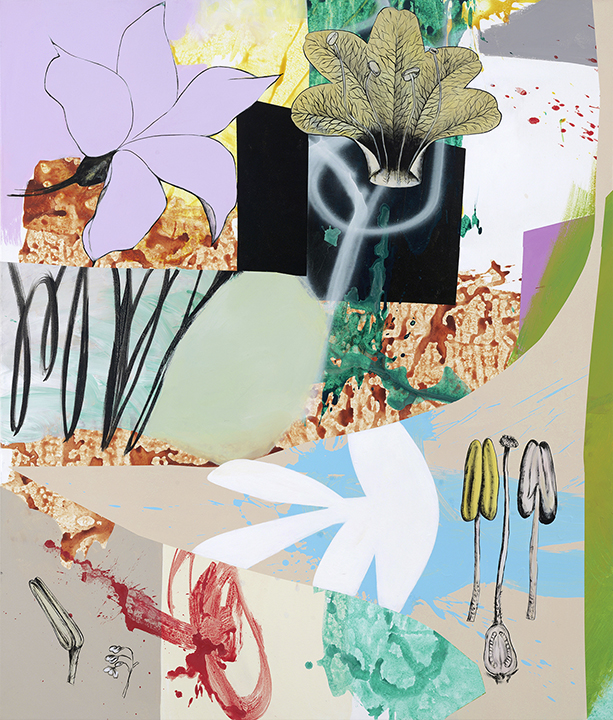The Orchid and The Bee
'The Orchid and The Bee' was written and recorded to accompany the exhibition Herbaria, at Gallery Jones in Vancouver, June 13 - July 13 2019. Song & lyrics by Fiona Ackerman Vocal performance by Amber Webber.
Tulip, (2019), acrylic on canvas, 59 x 59 inches
Painting for Dorothea and Johanna (2019), acrylic on canvas, 56 x 82 inches.
Painting for Maria Sibylla Merian (2019), acrylic on canvas, 48 x 90 inches.
Orion (2019), acrylic on canvas, 48 x 36 inches.
Under Garden (2019), acrylic on canvas, 64 x 40 inches.
Herbaria (2019), acrylic on canvas, 60 x 60 inches.
Cosmos (2019), acrylic on canvas, 59 x 39 inches.
Aerial Botanical (2019), acrylic on canvas, 54 x 46 inches.
Naturata Naturans (2019), acrylic on canvas, 62 x 62 inches.
The Orchid and the Bee (2019), acrylic on canvas, 43 x 56 inches.
Orchidaceae (2019), acrylic on canvas, 30 x 24 inches.
Herbaria
The paintings in this exhibition were inspired by the works of botanical artists who documented plants and flowers through the medium of painting and drawing, for scientific purposes. Particularly, Maria Sybilla Merian, (1647-1717) a German-born naturalist and scientific illustrator who worked extensively in South America. Considered a pioneer in the field, Merian was one of the first to study insects. She recorded and illustrated the life cycles of 186 insect species, and is credited as the first to illustrate the process of metamorphosis, showing the insect on its host plant.
After her death, her paintings were purchased by the Tsar of Russia. Her daughters Dorothea Maria and Johanna Helena became noted botanical artists, Dorothea at the Russian Academy of Sciences, and Johanna as a naturalist in Suriname. At a time when visual arts as a vocation was almost exclusively dominated by men, these women and a handful of others had significant careers; their work survives in the annals of science, offering a powerful testament to how women’s creativity flourished, at a time when it was more often stifled by the marketplace and social structures. While it was acceptable, even desirable, for women to pursue painting and drawing as a hobby in the 17th and 18th Centuries, botanical artists were able to forge important artistic and scientific careers, and earn a living.
The Golden Age of Botanical Painting is considered to have been 1750 to 1850, coinciding with the Age of Imperialism, when legions left Europe to explore, conquer, colonize and document the non-western world. In Canada, Catherine Parr Trail and her sister Susanna Moodie, as well as their daughters and granddaughters, made memorable contributions to the field. In old age, Traill received a pension from the Royal Bounty Fund in recognition of books and pictorial documentation of Ontario wildflowers and plants. As lives of the artists go, these women stand out historically for having applied their immense creative talents to the service of science and discovery.
What struck me, as I discovered their substantial body of work, was the powerful tension between the medium’s requirement for accuracy, documentation, and the dynamic of interpretation, which motivates the artist. Almost always, they look at nature and find a tangled garden. A lady’s ambivalence to the rough. An artist’s reaction to life in the full, away from the drawing room.
Herbarium is an 18th Century word, from Latin, denoting a systematically arranged collection of dried plants; also a box, cabinet, room or building housing such a collection. Herberia is the plural. It seemed important to reach into history to title a group of paintings that sprang from the far-off adventures of other women artists, and took me to a place where the last seven years of my artistic practice had been heading anyway. My exploration of the real world versus painted life began with Expeditions Through the Mirror (Winsor Gallery, 2012), which explored Michel Foucault’s idea of heterotopia, the inversion of reality through reflection to achieve higher truth.
Glasslands (Winsor Gallery, 2016) and Glasslands II (Galerie Kremers, Berlin, 2017) explored the idea of the garden as both a reflection of the natural world and an artificial construction. The garden on canvas as site and symbol of imagination, a wholly artificial construct where we harness the wild and reinvent our world. Defined by boundaries and dependent on enclosure, the garden occupies an in-between space reflecting seemingly opposing forces. A proposed utopia, it is a re-writing of the wild through exclusion and curation.
Painting offers me a way into a subject. It is a doorway through which I follow my interest in philosophy and art history. One body of work makes way for the next, with a logic that defies calculation but is utterly reliable.
With Herbaria, I set out to take history and science into the realm of abstraction and free aesthetic expression. It was gratifying to paint with one hand on the shoulders of the greats.
Fiona Ackerman,
Vancouver, May 2019











